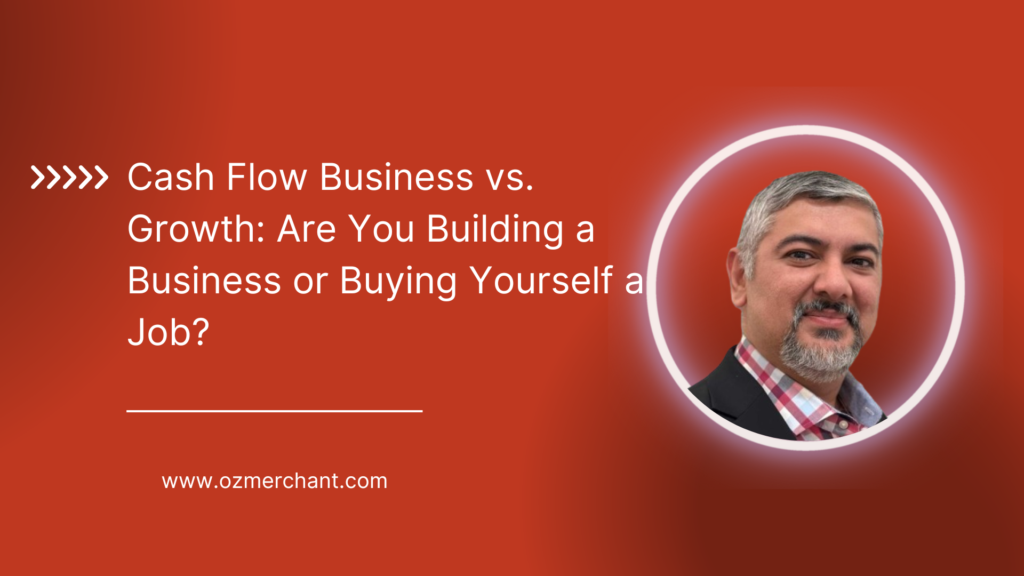Ever feel like you’re working harder, reinvesting every dollar back into your business, yet not seeing the payoff? If you’re building a cash flow business and never take money off the table, you didn’t build a business—you bought yourself a job.
On the flip side, if you’re pulling profits too early in a growth business, you’re sabotaging the very engine that’s supposed to scale your success.
The key is understanding what type of business you’re building and how your decisions around reinvestment, ROI, and profit-taking impact your future.
Too many founders blur the lines between cash a flow business and growth one. They reinvest indiscriminately or take profits at the wrong time, creating unnecessary financial strain.
Let’s break down the difference between these two models, the role of reinvestment, and how ROI should guide every decision you make.
Step 1: Know the Core Difference
The fundamental difference between a cash flow business and a growth business lies in how profits are used:
- Cash Flow Business: Prioritizes immediate, steady income. The goal is personal financial stability and independence.
- Growth Business: Prioritizes reinvestment for long-term scale, often delaying personal paydays to achieve massive returns later.
When you understand this distinction, it’s easier to avoid the pitfalls of treating one like the other.
Step 2: Avoid “Job Trap” Thinking in a Cash Flow Business
A cash flow business exists to pay you, not just to grow endlessly. If you reinvest every dollar back into operations, you’re not scaling—you’re spinning your wheels.
Here’s what happens:
- You never build personal wealth because you’re constantly funding the business.
- You end up working harder for diminishing returns.
- You’re putting all your eggs in one basket
Solution: Start treating your cash flow business like an ATM—not in the greedy sense, but as a consistent source of cash flow to fund your life and other opportunities. Business is inherently risky. Markets are always in flux. Taking the cash and investing in more conservative avenues may help you sleep better during the downturns.
Action Steps:
- Set a Profit Goal: Aim to take 15% of profits as owner’s pay every month.
- Invest in the Business: Reinvest 50% of the profits into areas that deliver at least a 3-5x return on investment (ROI).
- Invest on or Outside the Business: Take 30% and invest it in assets that yield lower returns but are less risky.
- Build a Reserve: Funnel 5% of profits into a sleep-well fund to protect your cash flow.
Example: Let’s say you earn $10,000 in monthly profit. You take $500 to build reserves, $1,500 for owner’s pay, and reinvest the remaining $5,000 only in high-ROI areas like marketing campaigns or automation tools. You can squirrel away the $3,000 as a down payment for the building or warehouse you are using. Start using your cash flow to build your asset empire.
Step 3: Avoid “Cash Grab” Thinking in a Growth Business
In a growth business, taking profits too early is like eating your seed corn. Reinvestment isn’t optional—it’s critical.
Every dollar pulled out is a dollar not working to:
- Acquire new customers.
- Expand into new markets.
- Develop the next product that differentiates you.
Solution: Think of reinvestment as a multiplier. The goal is to build momentum, even if it means delaying personal paydays. The key assumption here is that you’ve figured out your machine. I put a dollar in and generate $4 in return.
Action Steps:
- Prioritize High-ROI Investments: Reinvest at least 70-80% of profits into initiatives with scalable ROI (e.g., customer acquisition, technology upgrades).
- Set Milestones for Profit-Taking: Only take profits after hitting consistent growth benchmarks (e.g., revenue doubling in three quarters).
- Track ROI Like a Hawk: Use the “three is a trend” rule. One quarter of low ROI might be noise, but three quarters signal it’s time to pivot.
Example: A SaaS business generates $50,000 in monthly profit. The founder reinvests $40,000 into customer acquisition campaigns with a projected ROI of 4x, saving $5,000 for operating reserves and limiting personal pay to $5,000.
Step 4: Let ROI Guide Every Decision
ROI isn’t just a number—it’s the compass for your business. Whether you’re running a cash flow or growth business, reinvestment decisions should follow this formula:
- Measure ROI Before You Invest: Ask, “What’s the projected return, and how quickly will I see it?”
- Test Small Before Scaling: Don’t throw all your profits into a single strategy. Start with 10-20% of profits to test, then scale what works.
- Monitor Trends: Track ROI over time. Use the “one is a point, two is a line, three is a trend” (an analogy I stole from Tobi Walter – thanks!) rule to avoid overcommitting to strategies that don’t deliver.
Pro Tip: Create a dashboard to track ROI by category (e.g., marketing, technology, hiring) and review it monthly.
Step 5: Balance Reinvestment and Payouts
The art of building a business lies in balancing growth and personal reward. Here’s how to strike that balance:
In a Cash Flow Business:
- Take payouts consistently to avoid burnout and financial instability. (Note: Be mindful of the seasonality in your business)
- Reinvest cautiously, focusing only on initiatives with predictable ROI.
In a Growth Business:
- Delay payouts until key milestones are hit (e.g., hitting $1M ARR or acquiring 1,000 customers).
- Reinvest aggressively but strategically, ensuring every dollar works toward scaling.
Final Reflection:
Running a business is a constant tradeoff between immediate rewards and long-term potential. If you treat a cash flow business like a growth machine, you’ll burn out with nothing to show for it. If you treat a growth business like a cash cow, you’ll kill its momentum.
So, ask yourself:
- Are you reinvesting for ROI, or just reinvesting to “grow”?
- Are you taking money off the table, or working harder for the same returns?
Take 10 minutes to review where your profits are going. Align them with the business you’re truly building.


